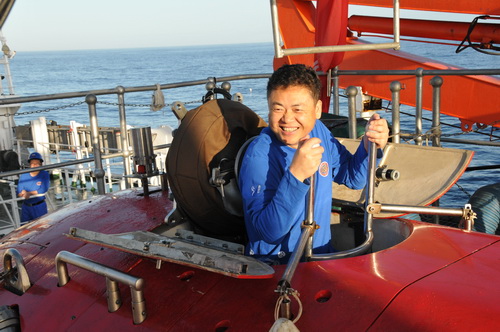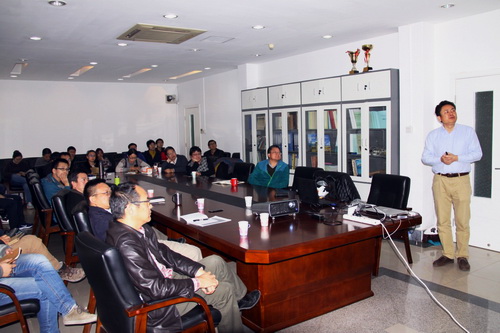At the invitation of Key Laboratory of Mineral Resources, Prof. TAO Chunhui, a research fellow from the Second Institute of Oceanography, the State Oceanic Administration (SOA), visited IGG on November 29, 2016, for academic exchange. Tao’s recent research has been devoted to the exploration and evaluation of submarine mineral resources. He is China’s first scientist to find the submarine hydrothermal region in mid-oceanic ridges, and led the exploration team that found the hydrothermal regions in the mid-oceanic ridges of the world’s three main oceans.
TAO gave a wonderful report entitled Challenge and Opportunity--Process of the Investigation on Submarine Polymetallic Sulfides in Southwest Indian Ocean. The seminar was presided over by Qing Kezhang. Many research fellows, associate research fellows, post-doctors and undergraduates attended the seminar. The seminar included three parts focusing on submarine hydrothermal activity and sulfides, the exploration in the contract zone in southwest Indian ocean, and challenges and opportunity. TAO first briefly introduced the geological processes in hydrothermal ore deposition around submarine volcanoes and the relevant specifications in international submarine exploration and contract application. Next, he focused on the discovery of the submarine sulfide deposits in southeast Indian Ocean. Currently, submarine volcano hydrothermal areas found by the foreign scholars were mainly distributed in the medium- and slow-spreading mid-oceanic ridges, while TAO’s group found the first moving hydrothermal area in the ultra-slow spreading mid-oceanic ridge in the southeast Indian Ocean.
This hydrothermal area is also the first hydrothermal area found by Chinese researchers and shows significant progress in scientific research, which has become a hotspot in international academic community. Research results show that the highest temperature of hydrothermal fluid in this region can reach up to 380°C; many sulfides such as pyrites and sphalerites were developed; the species flourished in the low-temperature region (145°C), and some special creatures such as Zingiber mioga and blind shrimp were found. According to the existing exploration results, this contract zone has great resource potential.
China now has a sulfide exploration contract in this region, which is the first global sulfide exploration contract of 10 thousands of square kilometers. Finally, when discussing opportunities and challenges, TAO pointed out that the investigation of submarine hydrothermal solutions and sulfides would provide good opportunities for the development of China’s deep sea exploration and evaluation towards three-dimensional stereoscopic exploration. Great breakthroughs are expected to be made in fundamental research on ultra-slow spreading mid-oceanic ridges. Additionally, new progress will be made in the coupling research of biodiversity and environment.
The participants had a heated discussion and exchange on the exploitation and utilization of submarine thermal energy resources and sulfide deposits, the verification of drilling projects, the comparison between old and new VMS deposits and their indication on palaeoenvironment, the particularity of the biocenoses in submarine hydrothermal regions and the causes of carbonate rocks in ultra-slow spreading mid-oceanic ridges.

A photo of TAO going out of the cabin of Jiaolong (Photo provided by TAO)

TAO is giving a report (Image by IGG)